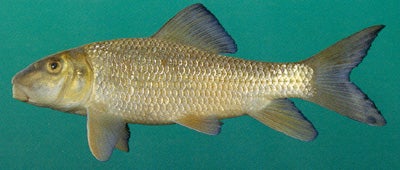SCIENTIFIC NAME: Moxostoma anisurum
CHARACTERISTICS: The silver redhorse and the river redhorse, Moxostoma carinatum, can be distinguished by fin color, lip shape, and number of dorsal fin rays. Silver redhorses have a light gray to tan dorsal fin, and the pectoral, pelvic, and anal fins are beige to orange. The halves of the silver redhorse’s lower lip meet at an acute angle, and the dorsal fin contains 14 to 16 rays. The river redhorse, on the other hand, usually has bright red caudal and anal fins, lower lips that meet at an obtuse angle; and a dorsal fin that contains 12 or 13 rays.
ADULT SIZE: 12 to 28 in (300 to 711 mm). This species and the river redhorse are the two largest Moxostoma species in Alabama.
STATE RECORD:
a list of the State Record Freshwater Fish.
DISTRIBUTION: The southern bend of the Tennessee River drainage marks the southern extent of the silver redhorse’s range in Alabama. Jenkins (1980a) and Boschung (1992) include records collected by Tennessee Valley Authority biologists in 1936 and 1938. None are reported from Bear Creek (Wall, 1968). Jandebeur (1972) includes one Elk River collection from Tennessee, and Feeman (1987) includes one from the upper Paint Rock River. We collected silver redhorses at 10 new stations in the Tennessee River drainage from 1991 to 1993. Future sampling will undoubtedly expand the known range of this species in state waters.
HABITAT AND BIOLOGY: We have collected silver redhorses in the Tennessee River proper and in medium-sized and large streams having moderate to fast currents and silt, sand, gravel, and bedrock substrates. Interestingly, most of the individuals we examined during our electrofishing surveys ranged from 10 to 20 inches long; we found no small individuals. Hackney et al. (1971) report on spawning time, age, growth, and the sport fishery for this species in the Flint River, a tributary to Wheeler Reservoir in northern Alabama. Spawning occurs in March and April over gravel shoal areas in moderate to swift currents. Food items consist primarily of the Asian clam Corbicula and aquatic insect larvae. Silver redhorses live for up to eight years. This species is an excellent food fish (Hackney et al., 1971); but because its flesh contains small intermuscular bones, it must be thoroughly cooked before being served.
ORIGINAL DESCRIPTION: Rafinesque described the silver redhorse in 1820.
ETYMOLOGY:
Moxostoma means mouth to suck.
Anisurum means unequal tail.
The copyrighted information above is from Fishes of Alabama and the Mobile Basin.






